Blog Standard

Advancing Nanoscale Research with WaveMode NMA Technology
The ability to characterize material properties at the nanoscale is pivotal for breakthroughs in material science applications, soft matter and life-science applications, and emerging fields like photothermal therapy. Nanosurf’s WaveMode NMA, a cutting-edge advancement in Atomic Force Microscopy (AFM), sets a new standard for High-speed nanomechanical mapping. By leveraging photothermal actuation and the intuitive Nanosurf Studio software, WaveMode NMA delivers rapid, precise, and quantitative Nanomechanical analysis, empowering researchers to explore nanomechanical systems with unparalleled efficiency. This blog explores the principles, features, and applications of WaveMode NMA, highlighting its transformative role in afm analysis.
The Innovation of WaveMode NMA
WaveMode NMA is the cornerstone of Nanosurf’s nanomechanical characterization suite for the DriveAFM, combining photothermal actuation with off-resonance tapping for High-speed nanomechanical mapping. As the fastest commercial method for Force curve acquisition, it offers exceptional temporal resolution and force sensitivity, enabling comprehensive Nanomechanical analysis across large sample areas in significantly reduced timeframes compared to traditional force mapping methods (see Figure 1, which illustrates the nanomechanics portfolio selection guide, plotting WaveMode NMA, Modular Force Spectroscopy, and Viscoelastic Analysis against sample stiffness and measurement frequency).
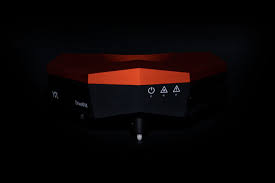
Nanosurf DriveAFM
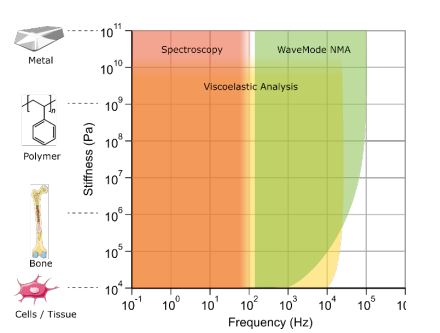
[Figure 1: Nanosurf nanomechanics portfolio selection guide. The graph displays three complementary methods (classical force spectroscopy, viscoelastic analysis, and WaveMode NMA) plotted against sample stiffness and measurement frequency. Shaded regions indicate the optimal application range for each technique. To select the appropriate method, identify your sample's stiffness range and required measurement frequency, then choose the technique whose shaded area encompasses that point. WaveMode NMA offers the fastest force-curve acquisition across a wide range of sample stiffnesses.]
By operating off-resonance, WaveMode NMA eliminates the speed limitations of piezo-driven approaches, delivering direct, quantitative measurements of material properties. This quasi-static operation simplifies data interpretation, making it ideal for material science applications and soft matter and life-science applications, including photothermal therapy research.
Key Features and Benefits
- Unprecedented Speed: WaveMode NMA achieves high speed afm through rapid Force curve acquisition, enhancing productivity without compromising data quality.
- Quantitative Accuracy: Off-resonance operation provides straightforward measurements of nanomechanical systems, including indentation depth, adhesion force, and Young’s modulus.
- Streamlined Workflow: Integrated into Nanosurf Studio software, WaveMode NMA supports live analysis, allowing real-time visualization and parameter optimization for efficient afm analysis.
- Versatile Applications: The technique supports Modular Force Spectroscopy and Viscoelastic Analysis, accommodating materials from soft biological samples to those with high elastic moduli.
Calibration and Operation
Calibration for WaveMode NMA is seamlessly integrated into Nanosurf Studio software’s automatic cantilever calibration procedure, requiring only a hard reference sample like silicon, glass, or sapphire (see Figure 2, showing the calibration widget and live oscilloscope for parameter selection). This streamlined process enhances user experience and minimizes setup time. The workflow mirrors classical WaveMode imaging, ensuring a minimal learning curve for researchers transitioning to high speed afm.
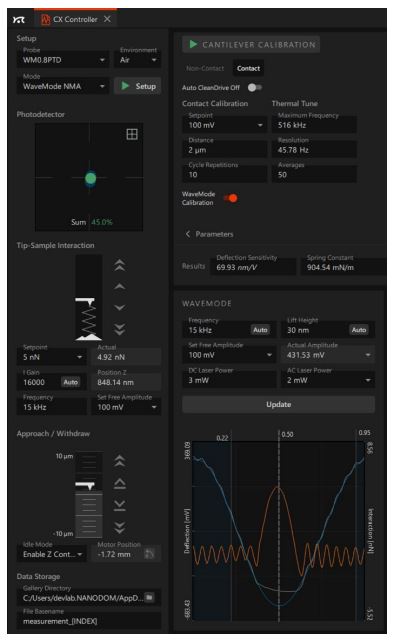
[Figure 2: WaveMode NMA in Nanosurf Studio. Upper widget: The WaveMode NMA calibration process is fully incorporated in the Cantilever Calibration procedure (available from Nanosurf Studio 14 on). Lower widget: The live oscilloscope supports the user selecting appropriate WaveMode parameters.]
In WaveMode NMA, the tip is modulated sinusoidally via photothermal actuation, ensuring a reliable trajectory. The deflection signal measures tip-sample interactions both out-of-contact and in-contact, with the cantilever’s bending shape accounting for accurate analysis. The oscillation frequency is capped at 10% of the cantilever’s resonance frequency to avoid resonance effects, enabling high speed afm and simplified data interpretation. Force-distance curves are evaluated using contact mechanics models (Hertz, Sneddon, DMT) to extract mechanical properties, as shown in Figure 3, which displays an interaction curve on an SBS sample with a DMT model fit and analysis parameters.
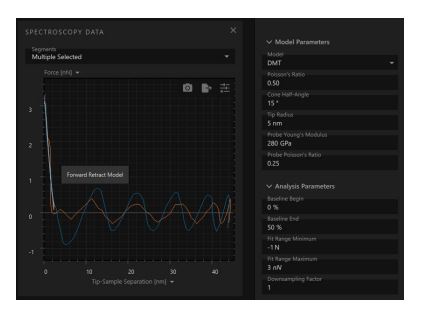
[Figure 3: Analysis Tab in Studio. A WaveMode NMA nteraction curve measured on an SBS sample (25 kHz WaveMode frequency) is shown together with the DMT Model fit. A selection of analysis parameters is shown on the right-hand side.]
Specialized Probes for Diverse Applications
Nanosurf offers probes optimized for WaveMode NMA, each tailored to specific sample stiffness ranges and applications (see Figure 4a, illustrating photothermal frequency sweeps and operational ranges):
- WM0.1Au-SS (5 MPa–500 MPa): Designed for soft matter and life-science applications, ideal for delicate biological structures and soft polymers, minimizing deformation.
- WM0.8PTD (50 MPa–5 GPa): Balanced for general polymer characterization and material science applications, offering versatility across sample types.
- WM 20 PTD (500 MPa–50 GPa): Optimized for high elastic moduli materials like metals and ceramics, ensuring reliable measurements on rigid surfaces.
These probes enable WaveMode NMA to address a wide range of research needs, from photothermal therapy studies to advanced materials development.
Real-World Applications
WaveMode NMA excels in diverse applications. For example, a micro-phase separated polymer blend (PS-SBS) was mapped using a WM0.8PTD probe, producing a Young’s modulus range of 0.1–3.2 GPa over a 6 µm scan at 19 kHz (see Figure 4c, showing a 3D topography with Young’s modulus overlay, and Figure 4b, a histogram of Young’s modulus values). Similarly, a Sn63Pb37 solder alloy was analyzed with a WM20PTD probe, achieving an 18–112 GPa range over a 2 µm scan at 20 kHz (see Figure 4d). These examples highlight WaveMode NMA’s capability for detailed Nanomechanical analysis across material science applications.
The Nanosurf Studio software enhances these results with live analysis, evaluating parameters like indentation depth and adhesion force in real-time, supporting Viscoelastic Analysis for diverse sample types.
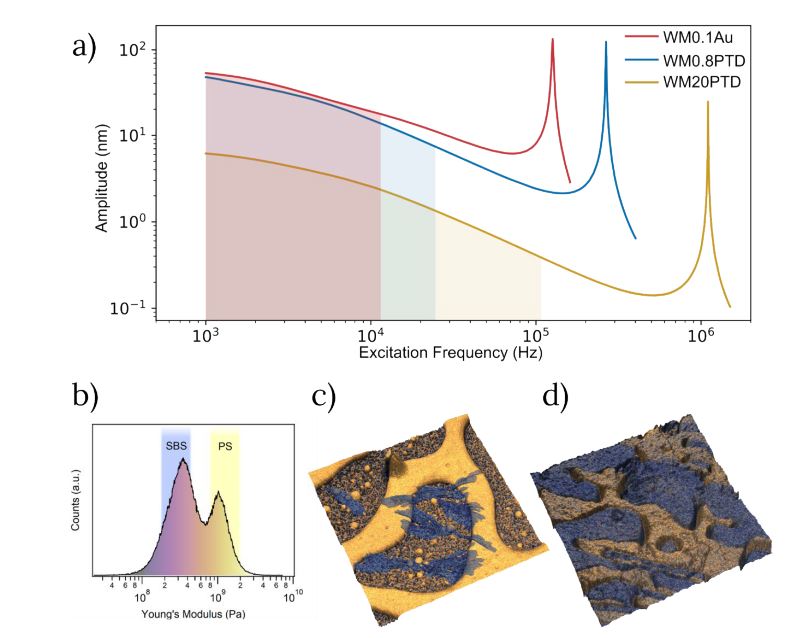
[Figure 4: a) Photothermal frequency sweeps of selected WaveMode probes are shown in the upper graph. The shaded areas highlight the typical WaveMode frequency range for the respective probes. b) The histogram of the distribution of Young’s Modulus values obtained from image c). c) Micro-phase separated polymer blend of polystyrene and styrene-butadiene-styrene copolymer (PS-SBS) acquired using a WM0.8PTD probe (6 um scan size, 19 kHz WaveMode frequency, 0.1 -3.2 GPa log color scale); d) Sn63Pb37 solder alloy acquired with a WM20PTD probe (2 um scan size, 20 kHz WaveMode frequency, 18 -112 GPa log color scale). WaveMode NMA maps in c) and d) are displayed as 3-dimensional topography with a Young’s Modulus overlay.]
Advantages Over Traditional Methods
Compared to classical WaveMode imaging and traditional force curve-based approaches, WaveMode NMA leverages photothermal actuation to achieve high speed afm, overcoming speed limitations and enabling rapid dataset collection. The Nanosurf Studio software provides real-time insights via live analysis, making WaveMode NMA a versatile tool for academic research, industrial R&D, and quality control in nanomechanical systems.
Conclusion
Nanosurf’s WaveMode NMA redefines Atomic Force Microscopy by delivering High-speed nanomechanical mapping and precise Nanomechanical analysis for applications ranging from soft matter and life-science applications to material science applications. With photothermal actuation, specialized probes, and Nanosurf Studio software, it offers unmatched speed, accuracy, and ease of use, enabling researchers to explore nanomechanical systems with deeper insights. Whether advancing photothermal therapy or characterizing high elastic moduli materials, WaveMode NMA is a game-changer.
Inkarp Instruments s is a leading distributor and trusted service provider for Nanosurf products in India. With a strong dedication to innovation and quality, Inkarp delivers high-precision scientific instruments and expert support, empowering researchers nationwide to explore new frontiers in science.
References:Nanosurf

